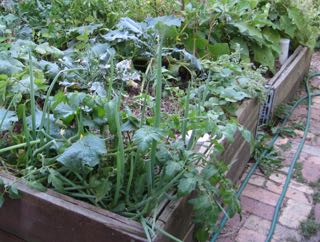Raised garden beds are useful to separate the garden bed from the paths and thus protect the soil from people walking on it. It’s a great way to keep mulch contained within the bed, and you can add a framework to protect your plants from insect pests.
If you make it waist height you can avoid bending or kneeling; and keep the family dog away; and grow veggies when you have tree roots or concrete at ground level.
It is generally recommended that a raised bed is no more than 1.2m wide so that you can reach the middle of the bed.
The height can be about 25-30cm or up to waist height.
It takes time and money to set up, as you need edging material and you generally have to bring in a suitable nutrient-rich mix of compost to fill the bed.
For the edging material avoid anything toxic such as treated or painted timber. You could use Reclaimed Cypress Sleepers (Cupresses macrocarpa) or any re-used untreated timber. Other options are pavers, concrete Besser blocks, corrugated iron or eWood (made in Victoria of recycled polystyrene).
Angelo Eliades gives detailed instructions on how to build a raised bed on his wonderfully informative website called Deep Green Permaculture: Connecting People to Nature, Empowering People to Live Sustainably.
Here is an excerpt from his article on Raised Garden Beds:
“You can use a variety of materials to construct raised beds. If you can, recycle any materials before you go out and buy new stuff, it’s cheaper and more sustainable… Pavers make great edging material that lasts virtually forever, and this works great when edging up to a concrete path…”
Angelo goes on to say:
“You can use raised garden beds to overcome issues of poor drainage, poor soil, or even no soil, such as gardening on top of straight concrete or asphalt, because you create the garden bed and fill it with the type of soil you require, and build it by adding organic matter.”
Read more on his website https://deepgreenpermaculture.com/diy-instructions/raised-garden-beds/

